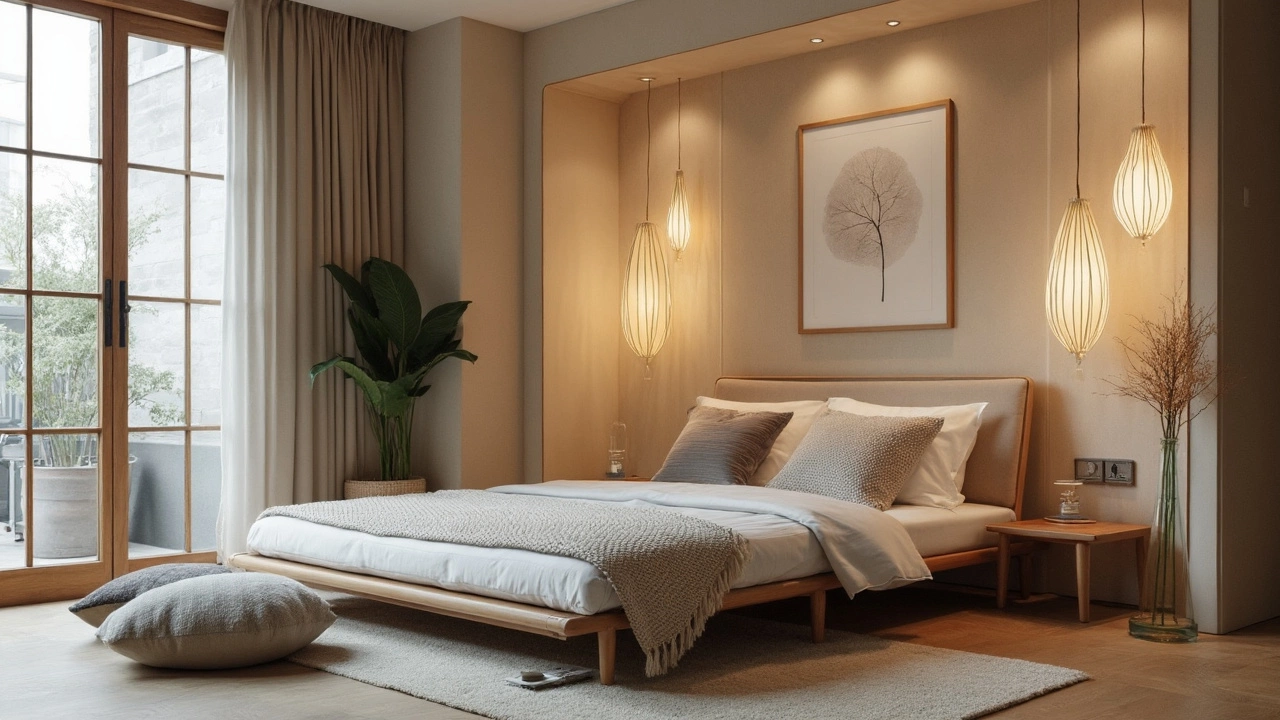
You might think you know what a sofa bed is, but Japanese sofa beds are a whole different beast. Imagine a couch that doesn't try to hide its true self, that's both practical and quietly stylish. Picture a place you can sprawl out to play video games or watch a movie, and then – in less than a minute – turn into a comfy bed that actually lets you sleep well. The funny thing is, Japanese sofa beds haven’t flooded big-box stores outside Japan. You see glimpses on Netflix dramas or in those apartment tour videos from Tokyo, but in person? Not so often. Let’s pull back the cover, see why they’re not just some novelty, and why, honestly, I sometimes wish our living room had made the jump to full-on Japanese style – especially during sleepover season for my daughter Elara and her friends.
Japanese sofa beds start with an idea that feels almost too simple: why let a couch take up so much room for just sitting? Japanese homes, especially in cities like Tokyo or Osaka, are famously tiny. Here, every square foot counts. So, instead of big heavy couches, lots of homes use futons – not the clunky futon frames you might have seen in college apartments, but sleek, foldable mattresses or cushions called "shikibuton." These lay directly on the floor, and at night, you just unroll your bedding, catch your Z's, then stash everything away the next morning. No frames, no springs. That’s where the Japanese sofa bed comes in – it borrows this lightweight, modular idea and brings it into the world of couches.
Imagine a low, supportive think-pillow that's both perfectly sized for sitting and easy to open up into a bed. They don’t use the classic Western pull-out mattress with a metal frame; everything is about transformation and efficiency. Shikibutons and sometimes a foldable backrest or stackable cushions do the trick. Some Japanese sofa beds take on a traditional "zaisu" (legless chair) vibe, while others might mimic the clean lines of Scandinavian sofas. You won’t find cup holders or secret USB ports here – this is the kind of furniture that asks you to pare down and chill out. The design often aims to complement tatami mat floors, sliding doors, and that serene, minimalist energy you see in Japanese interiors.
Japanese sofa beds are all about blending in…and then surprising you. Think minimalist lines, muted colors, and natural fabrics like cotton, linen, or wool blends. Most sit low to the ground, which creates an easy-going, laid-back vibe. In fact, low seating isn’t just a trend – it connects to traditional floor culture in Japan, where families often sit at low tables on zabuton cushions for meals. You’ll find shapes that follow this lead: simple rectangles, clean edges, maybe with a little bolster pillow tossed in for comfort. I’ve seen real futon makers build sofa beds that use the exact same cotton batting and construction as classic futons, with the bonus that you can refold them from a sofa stack to a flat bed in seconds. If you live somewhere hot and humid – like me, sweating it out in the summer while Lillian swears she’s “fine” at 28 degrees Celsius – this design lets everything breathe. You can easily air out the cushions, dry them in the sun, or slip off a cover for washing. That’s a big difference from those Western sofa beds where lost coins and crumbs fester in the creases for a decade.
What about color and style? Japanese sofa beds tend to stick with earthy tones: charcoal, cream, slate blue, or forest green. There’s a warmth and simplicity that makes a small space feel open, not cluttered. But here’s the kicker – many versions come modular. You can add an extra chunk to turn a loveseat into a wider sleeper, or even combine with tatami mat squares to build a full-on platform bed. The most famous modern style is the “three-fold” shikibuton: fold it up for a sofa, lay it flat for a bed, and fold in half for a sort of low lounge chair. No complicated mechanical parts to jam or break! That modular, mix-and-match style means you can keep rearranging the room, which is a lifesaver if your space pulls double duty like ours does when Elara’s LEGO castle takes over the living room.

If you know the pain of sleeping on a Western pull-out, you get what sets Japanese sofa beds apart right away. Standard Western sofa beds usually have a spring mattress crammed inside a metal frame, right? That setup makes the "mattress" thin, floppy, and full of weird lumps. Sleeping on one means choosing between back pain, cold bars across your spine, or giving up and moving to the floor. The Japanese model ditches the frame and crazy foam blocks. Instead, it uses thick layers of cotton or sometimes memory foam, designed for both sitting and sleeping. You’re basically lying on the same thing you were sitting on, so nothing sags, and there are no painful gaps. This is huge for comfort.
And here’s something a designer friend once pointed out: Japanese sofa beds age better. Since the covers are usually removable and the filling fluffs up with sun and hand-pounding, you can keep them fresh for years. Try removing the mattress cover on a Western sofa bed – not happening. Also, Japanese sofa beds often weigh much less. Moving one to clean or completely rearrange the room is actually possible solo, instead of having to call four friends and offer pizza. In Tokyo, people even drag their futons out on balconies to air out every week (it helps avoid dust mites and feels pretty good in the sun). Western models? Just pray nobody knocks over a soda.
One final thing to chew on: Japanese sofa beds aren't only for sleeping. Lots of Japanese homes use the sofa bed as the main place to crash, read, or work – not just for guests or the occasional nap. It’s furniture meant for real living, not hiding in the guest room.
Tiny city apartment? Check. Student dorm room? Of course. But you don’t have to live in a shoebox to benefit. My own place isn’t all shoji screens and paper lamps – but we’ve got rooms that need to serve more than one purpose. When our daughter Elara has friends over, our living room morphs into “the sleep zone,” and something modular and easy to unfold is way less hassle than blowing up air mattresses or wresting a heavy couch into place at midnight. Japanese sofa beds handle this with zero drama.
I’ve spotted them in home offices, playrooms, basements, even in tiny Airbnbs where the space pulls double duty. Pet owners swear by them because you can usually wash the covers, and no springs or metal to break if your dog treats the couch like a playground. Parents love that the bed is so close to the floor – no worrying about kids falling out in their sleep. The real magic? They invite you to rethink how a room is used. The TV room can double as a guest bedroom. The bedroom can be a workspace by day. If you’re the kind of person who escapes on long weekends, you can even bring a folded sofa bed for car camping. It weighs less than most air mattresses and takes up barely any trunk space.
Some people even build a full Japanese-style room, complete with tatami mats and shikibuton-style sofa beds, for that spa-like, calming getaway vibe. It’s a definite switch from Western furniture, but it might just make you see your home differently. Trust me, watching Studio Ghibli movies on a Japanese sofa bed feels extra relaxing.

Before you rush out to buy the first thing labeled as “Japanese sofa bed” online, let’s get practical. Real Japanese sofa beds use layers of natural materials – high-quality cotton batting, sometimes wool, or more recently, supportive memory foam blends. Check if the cover’s removable and machine-washable; this matters way more than you think, especially if you live with pets or kids. If it comes with a wood frame, see how easy it is to assemble or take apart – the point is flexibility! Look for the word “shikibuton” when you shop; that usually guarantees you’re getting the real, roll-up style, not just a cheap couch with a strip of foam inside. Want the real deal you see in Japanese homes? Brands like MUJI, Nishikawa, and Tokyo Futon are a good place to start (though shipping might run high if you’re outside Asia).
Want a quick checklist? Here’s mine:
A quirky fact: In Japan, the government health guidelines literally recommend that people air out their bedding in the sun every week to avoid mold and dust mites. People hang futons out the window or pop them on sunny balconies. If you live in a humid part of the world, you’ll love how easy this makes keeping things fresh. I grew up with Western mattresses that would sometimes get that musty, “never truly dry” smell — with a Japanese sofa bed, you can actually tackle that, thanks to light weight and simple construction.
One thing I always say: expect a firmer sleep than what you might be used to from memory foam beds. The support is real – your body will thank you after a few nights, especially if you hate sagging spring mattresses. But if you prefer a super-cushy bed, toss an extra quilted topper on it. You control the feel, not the factory.
Storage is the other big perk. Maybe you want to reclaim your living room for morning yoga or the kids’ dance routines. Folding up a Japanese sofa bed is a breeze – no heavy parts, no tricky hinges. You can get soft storage bags for off-seasons or even under-bed bins.
And if you want to go all-out and create a “Japanese corner” in your home, add a low table (“chabudai”), a paper lantern, and a few big floor cushions. Suddenly, your home feels bigger, brighter, and totally modern.
If you’ve never tried sleeping on a Japanese sofa bed, give it a shot. There’s real charm in waking up, folding up your bed in seconds, and rolling seamlessly into the rest of your day. No complex gadgets or heavy lifting. Just unfussy comfort and a reminder that, sometimes, the simplest ideas make the best impact. Next time Elara’s pals are crashing for a movie marathon, I know exactly which piece of furniture is going to win the “best seat in the house.” And once they’re gone? I get the spot back. That’s what I call a win-win.
Write a comment